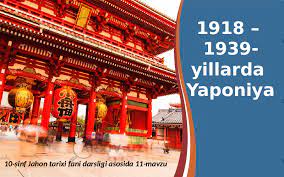SHARE WITH FRIENDS:
JAPAN in 1918-1939
PLAN:
-
Japan's interior
-
"Rice Rebellion".
-
Economic situation.
-
Japan's foreign policy.
-
Participation in the war.
Japan participated in the First World War on the side of the Entente. Consequently, he was among the winners. Entente did not leave Japan dry. He was given the mandate of the Shandong Peninsula, the Marian, Caroline, and Marshall Islands belonging to Germany in the Pacific Ocean. They allowed Japan to reach the center of the Pacific Ocean and approach the main US naval base, the Hawaiian Islands. Hastily began to occupy the market of the countries of the Far East and the Pacific Ocean. This, in turn, increased the profits of Japanese monopolies (Mitsui, Mitsubishi, Yasuda, Sumitomo). The standard of living of working people in the country has decreased. This phenomenon was expressed in the "Rice Rebellion" that occurred on August 1918, 3 in Toyama Prefecture.
This rebellion was caused by speculators raising the price of rice.
This rebellion, which shook the foundations of the Japanese colonial empire, greatly influenced the rise of a new wave of national liberation struggle in the colonies.
By the end of 1923, there was a revival in the Japanese economy. The restoration work that started after the earthquake that occurred on September 1 of this year created favorable conditions for this. Japanese monopolies lowered the prices of export goods in order to maintain large profit margins. Cast iron production in the country has doubled and reached 2 mln. to 1 tons, steel production from 100 tons to 842 million. It increased by 1 thousand tons. Universal suffrage was decided. 720 million voters. from 3 mln. increased to
The Japanese economy was a result of the weakness of the economy of other great countries, and the depth of the consequences of the earthquake that occurred in 1923. By 1931, industrial products decreased by 31 percent, exports by 65 percent, and imports by 72 percent. During the crisis, the number of unemployed was 3 million. established a person. Young officers were loyal to the emperor. They began to demand from the emperor to limit the dominance of the old concerns. They opposed the Parliament. In this way, Japan became fascist. They began to forcefully propagate the ideas of "panasia" and world domination. Young officers began to support the new concern's owners in their quest for power.
On May 1932, 15, a fascist uprising of young officers broke out. As a result, even the prime minister of the country, Inukai, was killed. Although the rebellion was suppressed, the military presence in the country was greater than ever. On February 1936, 26, the second fascist uprising was organized in which 1500 soldiers participated. Although the rebellion was put down on February 29, it greatly alarmed Japanese ruling circles.
After the war, Japan's relations with the USA in the Pacific basin became tense. On January 1925, 20, the Soviet state and Japan signed an agreement "On the Basic Principles of their Mutual Relations". According to him, Japan withdrew its last military units from the territory of Soviet Russia. However, this did not mean that the Japanese ruling circles gave up their claims to the territories of the Soviet Far East.
In September 1931, the Japanese army attacked northeastern China - Manchuria, and occupied it in early 1932. Japan withdrew from the League of Nations in March 1933.
From July 938 to August 29, 11, he attacked the territory of the Soviet state. This incident happened in the area of Lake Hasan (in Primorye). However, the Soviet army managed to clear its territory of Japanese troops.
On May 1939, 11, the Japanese army attacked the Mongolian People's Republic (MPR) (along the Khalkhin-Gol River). According to the mutual agreement, the Soviet army provided assistance to the People's Republic of China. The Japanese army was crushed in the war that lasted for four months. The Battle of Khalkhin Gol, the Soviet-German Treaty (August 1939, 23) forced Japan to change its relationship with the Soviet state.
Control questions.
-
What is the essence of the Panosian idea?
-
What is the Tanaka Memorandum?
-
In 1941 - 1942, Japan occupied Kaer.
-
Why did Japan get closer to Nazi Germany?
